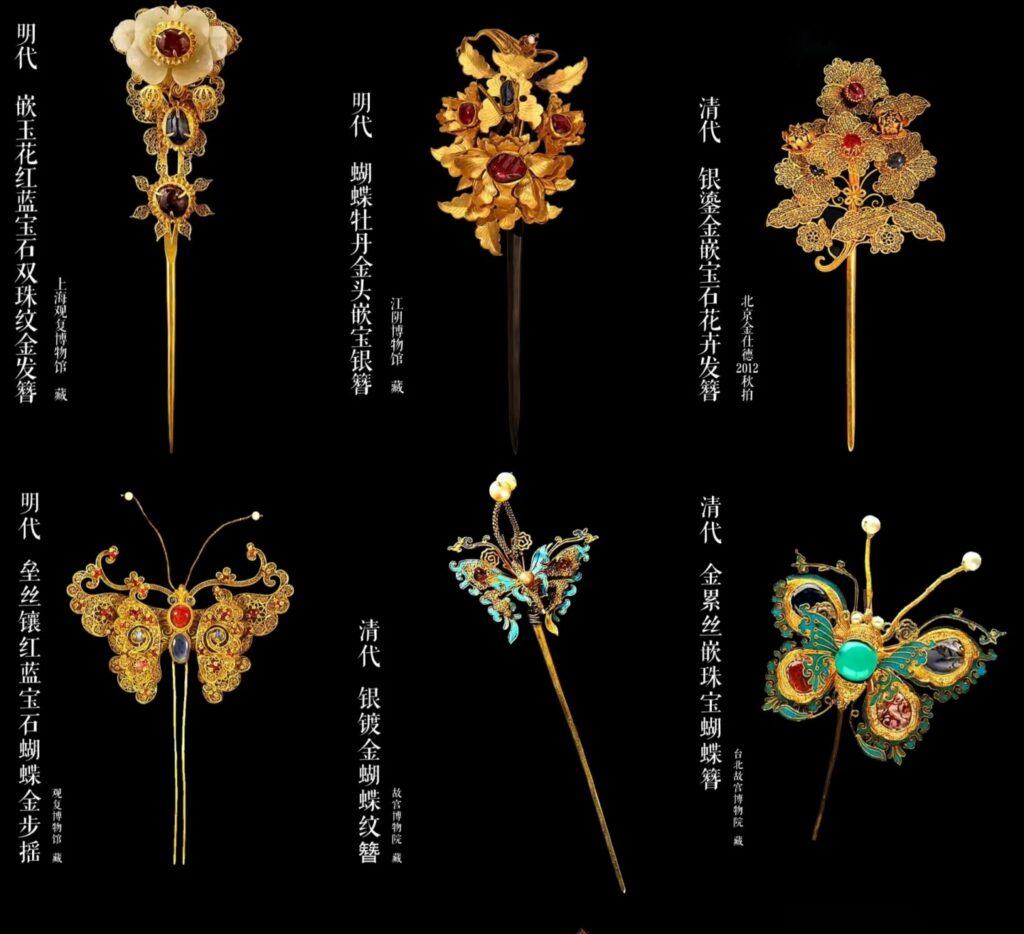
A Chinese hairpin, or “簪” (zān), is far more than an accessory—it carries centuries of history, artistry, and symbolism. From ancient rituals to romantic traditions, the hairpin reflects a refined cultural heritage that continues to inspire today.
What Is the Historical Origin of the Chinese Hairpin?
- Traces back to the Neolithic Age: Early hairpins, known as “笄” (jī), were discovered at archaeological sites such as Hemudu. These were made of bone, horn, stone, and jade.
- Shang and Zhou Dynasties: Hairpin-like accessories were primarily functional, made from basic materials like bone, stone, and bamboo.
- Qin and Han Dynasties: Hairpins became more refined, crafted from gold, silver, and jade—showcasing the early fusion of practicality and aesthetics.
- Tang and Song Dynasties: This was the golden age of hairpin design. Elaborate styles and intricate craftsmanship made them central to a woman’s ensemble.
- Ming and Qing Dynasties: The Ming period marked the peak of hairpin artistry, while the Qing era introduced even more elaborate forms, with added pearls, enamel, and filigree work.
What Are the Types and Styles of Chinese Hairpins?
- By structure: Single-pronged hair ornaments are called “簪” (zān), while double-pronged ones are called “钗” (chāi). A distinctive type known as “步摇” (bù yáo) includes dangling decorations that move gracefully with each step.
- By function: Some hairpins were purely functional, designed to secure hairstyles. Others, like “华胜” (huá shèng) and “钿子” (diàn zǐ), served ceremonial purposes. Specialty types include “挑心” (tiǎo xīn), “分心” (fēn xīn), and “满冠” (mǎn guàn), each with a specific cultural or symbolic role.
What Materials Were Used to Make Hairpins?
- Metals: Gold, silver, and bronze were commonly used. Examples include the gilded silver phoenix hairpins of the Liao Dynasty and the finely crafted gold hairpins from the Ming Dynasty.
- Jade and precious stones: Materials like jadeite and Hetian jade brought a sense of gentle elegance and refinement.
- Organic materials: Hairpins were also carved from bone, horn, ivory, and even tortoiseshell. Some imperial pieces from the Ming Dynasty were made from rare rhino horn. Others used wood or bamboo, especially in more rustic or artistic designs.
What Does a Hairpin Symbolize in Chinese Culture?
- A symbol of coming of age: In ancient China, a girl would participate in the “笄礼” (jī lǐ) at age 15. This hairpin ceremony marked her transition into adulthood and her eligibility for marriage.
- A token of love: Hairpins were often exchanged as love tokens between couples. Offering or accepting a hairpin was a gesture of commitment and emotional connection.
- A mark of status: The materials and craftsmanship of a hairpin often reflected the wearer’s social rank. Nobles and royal family members wore ornate hairpins adorned with precious metals and jewels, signaling their elevated position in society.
Conclusion
In Chinese culture, a hairpin is never just an ornament. It tells stories—of heritage, personal growth, love, and societal identity. Whether passed down through generations or worn as a statement of elegance, the Chinese hairpin is a timeless piece that speaks volumes with its quiet beauty.